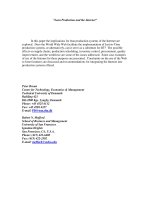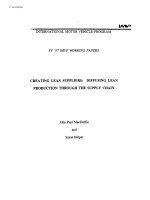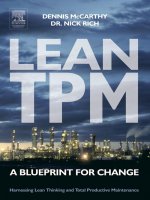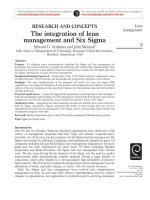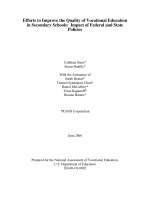Models lean lean maintenance reduce costs improve quality and increase market share
Bạn đang xem bản rút gọn của tài liệu. Xem và tải ngay bản đầy đủ của tài liệu tại đây (4.37 MB, 301 trang )
Lean Maintenance
Lean Maintenance
Ricky Smith
Bruce Hawkins
AMSTERDAM • BOSTON • HEIDELBERG • LONDON
NEW YORK • OXFORD • PARIS • SAN DIEGO
SAN FRANCISCO • SINGAPORE • SYDNEY • TOKYO
Elsevier Butterworth–Heinemann
200 Wheeler Road, Burlington, MA 01803, USA
Linacre House, Jordan Hill, Oxford OX2 8DP, UK
Copyright © 2004, Elsevier Inc. All rights reserved.
No part of this publication may be reproduced, stored in a retrieval system, or
transmitted in any form or by any means, electronic, mechanical, photocopying,
recording, or otherwise, without the prior written permission of the publisher.
Permissions may be sought directly from Elsevier’s Science & Technology Rights
Department in Oxford, UK: phone: (+44) 1865 843830, fax: (+44) 1865 853333,
e-mail: You may also complete your request on-line via
the Elsevier homepage (), by selecting “Customer Support” and then
“Obtaining Permissions.”
Recognizing the importance of preserving what has been written, Elsevier prints its
books on acid-free paper whenever possible.
Library of Congress Cataloging-in-Publication Data
Smith, Ricky.
Lean maintenance : reduce costs, improve quality, and increase market share /
Ricky Smith and Bruce Hawkins.
p. cm.—(Life cycle engineering)
Includes index.
ISBN 0-7506-7779-1
1. Production management. 2. Manufacturing processes. 3. Just-in-time systems.
I. Hawkins, Bruce. II. Title. III. Series.
TS155.S635 2004
658.5—dc22
2003026393
British Library Cataloguing-in-Publication Data
A catalogue record for this book is available from the British Library.
ISBN: 0-7506-7779-1
For information on all Butterworth–Heinemann publications
visit our Web site at www.bh.com
04 05 06 07 08 09 9 8 7 6 5 4 3 2 1
Printed in the United States of America
Dedication
Contributing Authors to the Lean Maintenance book were Randy
Heisler, Dan Dewald, and Erich Scheller.
Thanks to Joe Dvorak and Kevin Campbell, with Northop Grumman
Newport News Shipyard, for providing us with the stimulation to write
this book.
Thanks to John Day, formerly with Alumax, for giving us the vision of
true maintenance.
Very special thanks to Bill Klein for all of his contributions to this
book. Without Bill this book would not be possible.
We also want to offer thanks to Jim Fei, Chairman and CEO of Life
Cycle Engineering, Inc. Without Jim’s understanding and commitment to
the engineering and maintenance community, this could not have
happened.
v
Contents
1. Common Ground . . . . . . . . . . . . . . . . . . . . . . . . . . . . . . . . . . 1
1.1 THE HISTORY AND EVOLUTION OF LEAN, 1
1.1.1 Manufacturing Evolves, 1
1.1.2 The Influence of Henry Ford, 3
1.1.2.1 Waste—The Nemesis of Henry Ford, 3
1.1.2.2 Ford’s Influence on Japanese Manufacturing, 6
1.1.3 Japan’s Refinement of Ford’s Mass Production System, 7
1.1.3.1 The Kaizen Process, 9
1.2 LEAN MANUFACTURING AND LEAN
MAINTENANCE, 10
1.2.1 Elements of Lean Manufacturing, 10
1.2.1.1 Lean Thinking and the Lean Organization, 12
1.2.1.2 The Role of Maintenance, 13
1.3 GOVERNING PRINCIPLES: WHAT IS LEAN AND
WHAT IS NOT, 14
1.3.1 What Lean Manufacturing Isn’t, 14
1.3.2 What Lean Manufacturing Is, 16
1.4 RELATIONSHIPS IN THE LEAN ENVIRONMENT, 16
1.4.1 Information Integration in the Lean Organization, 16
1.5 SUMMARY OF LEAN CONCEPTS, 17
2. Goals and Objectives . . . . . . . . . . . . . . . . . . . . . . . . . . . . . . 20
2.1 THE PRIMARY GOALS AND OBJECTIVES OF
MANUFACTURING, 20
2.1.1 Sales, 21
2.1.2 Production, 22
2.1.3 The Manufacturing Budget, 22
2.1.3.1 Budget Elements, 23
2.1.3.2 Controlling Costs, 23
2.1.3.3 Optimizing Maintenance as a Cost Control
Measure, 27
2.1.3.4 CPU—The Bottom Line, 29
2.1.4 Growth and Continuous Improvement, 31
2.2 INTEGRATING LEAN GOALS WITH MAINTENANCE
GOALS, 31
2.2.1 Maintenance Objectives and Goals, 31
vii
viii
Lean Maintenance
2.2.1.1 Maintenance Objectives, 32
2.2.1.2 Maintenance Goals, 33
2.3 THE NEED FOR, AND GAINING, COMMITMENT, 35
2.3.1 The First Step: Top Level Management Buy-in, 35
2.3.1.1 The Good, 36
2.3.1.2 The Bad and the Ugly, 36
2.3.2 Selling at Each Level, 37
2.4 MEASURING PROGRESS, 38
2.4.1 Metrics, 38
2.4.2 Selecting Performance Indicators and Key Performance
Indicators, 41
2.4.3 Maintain and Publish the Track, 53
3. Total Productive Maintenance (TPM) . . . . . . . . . . . . . . . . . . 55
3.1 TPM (FINE-TUNED) IS LEAN MAINTENANCE, 55
3.1.1 Elements and Characteristics, 55
3.1.1.1 Organization, 59
3.1.1.2 Work Flow and the Work Order, 64
3.1.1.3 Support Functions, 67
3.1.2 Best Maintenance Practices and Maintenance
Excellence, 67
3.1.3 Maintenance Skills Training and Qualification, 71
3.1.4 MRO Storeroom, 74
3.1.5 Planning and Scheduling, 76
3.1.6 CMMS (Computerized Management Maintenance
System), 78
3.1.7 Maintenance Documentation, 84
3.1.8 Maintenance Engineering, 91
3.2 FINE-TUNING TPM USING RELIABILITY CENTERED
MAINTENANCE (RCM), 91
3.2.1 What RCM Accomplishes, 92
3.2.1.1 The Origins of RCM, 92
3.2.1.2 Properties of RCM, 93
3.2.2 Integrating RCM and TPM, 95
3.2.2.1 Equipment Criticality and Maintenance
Priorities, 96
3.2.2.2 Reliability Engineering, 96
4. Pre-Planning for Lean Maintenance . . . . . . . . . . . . . . . . . . 105
4.1 GAINING KNOWLEDGE / IMPARTING
KNOWLEDGE, 105
4.1.1 Selecting the Lean Maintenance Project Manager, 105
4.1.1.1 Necessary Attributes of Lean Maintenance PM, 106
4.1.1.2 Lean PM Duties and Responsibilities, 106
4.1.2 What You (the Lean PM) Should Know, 107
Table of Contents
ix
4.1.3 Who Else and How to Familiarize Support Activities, 113
4.1.3.1 Educating the Project Team, 113
4.2 THE TRANSFORMATION ROADMAP, 114
4.3 LEAN MAINTENANCE TRANSFORMATION KICK-OFF
MEETING, 121
4.4 PHASE 1: DEVELOPING THE POA&M AND THE
MASTER PLAN, 123
5. Launching the Master Plan (POA&M) . . . . . . . . . . . . . . . . . 125
5.1 THE SEQUENCE OF EVENTS, 125
5.1.1 Phase 2—The Lean Preparation Phase (Education), 126
5.1.1.1 5-S (Visual), 126
5.1.1.2 Standardized Work Flow, 128
5.1.1.3 Value Stream Mapping, 130
5.1.1.4 Just-in-Time (JIT) and Kanban “Pull” System, 132
5.1.1.5 Jidoka (Quality at the Source)—Poka Yoke
(Mistake Proofing), 133
5.1.1.6 Shewhart Cycle (PDSA), 133
5.1.2 Lean Pilot (Phase 3), 135
5.1.2.1 Selecting the Project, 135
5.1.2.2 The Pilot Kaizen Events, 138
6. Mobilizing and Expanding the Lean Transformation . . . . . 141
6.1 MOBILIZING LEAN IN THE MAINTENANCE
ORGANIZATION (PHASE 4), 141
6.1.1 Teams and Activities in Phase 4, 142
6.1.1.1 5-S and Visual Cues Campaigns, 144
6.1.1.2 Autonomous Operator Maintenance, 145
6.1.1.3 Action Team Leader Knowledge Sharing, 147
6.1.1.4 Completing Maintenance Mobilization, 148
6.1.2 Mobilization Brings Change, 149
6.1.2.1 New Roles for Management and Supervision, 149
6.1.2.2 A Change of Organizational Focus, 149
6.2 EXPANDING THE LEAN MAINTENANCE
TRANSFORMATION (Phase 5), 151
6.2.1 Lean Expansion Major Efforts, 152
6.2.1.1 Expanding to Purchasing, 152
6.2.1.2 Expansion to Maintenance Engineering, 155
6.2.1.3 Expansion to IT Department, 158
7. Sustaining Lean—Long Term Execution . . . . . . . . . . . . . . 160
7.1 SUSTAINING CONTINUOUS IMPROVEMENT
(PHASE 6), 160
7.1.1 Applying the Tools, 161
x
Lean Maintenance
7.1.1.1 Optimizing Maintenance Using Lean Tools, 162
7.1.1.2 The Sustaining Environment and Activities, 175
Appendix A: Checklists and Forms . . . . . . . . . . . . . . . . . . . . 179
Appendix B: Documentation Examples . . . . . . . . . . . . . . . . . 213
Appendix C: Articles of Interest
Glossary
. . . . . . . . . . . . . . . . . . . . . . 219
. . . . . . . . . . . . . . . . . . . . . . . . . . . . . . . . . . . . . . . . 265
Index . . . . . . . . . . . . . . . . . . . . . . . . . . . . . . . . . . . . . . . . . . . 271
Preface
Lean Maintenance is a relatively new term, coined in the last decade
of the twentieth century, but the principles are well established in Total
Productive Maintenance (TPM). Lean Maintenance—taking its lead
from Lean Manufacturing—applies some new techniques to TPM concepts to render a more structured implementation path. Tracing its roots
back to Henry Ford with modern refinements born in Japanese manufacturing, specifically the Toyota Production System (TPS), Lean seeks to
eliminate all forms of waste in the manufacturing process—including
waste in the maintenance operation. While the first chapter of this Lean
Maintenance Handbook seems to dwell on Lean Manufacturing and does
not address maintenance, there is a purpose for that. All Lean thinking—
the premise of Lean Manufacturing and Lean Maintenance—is originally
based on manufacturing processes. Some believed that everything else
would just naturally evolve, or fall into line, from those roots. Time,
however, has unmasked the difficulties of instituting “Lean” in production support operations, those areas adjacent to the manufacturing production process, such as maintenance, without the presence of some
prerequisite conditions. That topic is the subject of the remainder of this
book after initially establishing some common ground.
To reduce costs and improve production, most large manufacturing and
process companies that have embraced the Lean Enterprise concept
have taken an approach of building all of the systems and infrastructure
throughout the organization. The result of this traditional approach has
been erratic implementation efforts that often stall-out, or are terminated,
before the benefits come. Plants can accelerate their improvements with
much lower risk through the elimination of the defects that create work
and impede production efficiency. Optimizing the maintenance function
first will both increase maintenance time available to do further improvements and will reduce the defects that cause production downtime. Thus
cost reduction and improved production are immediate results from
establishing Lean maintenance operations as the first step in the overall
Lean Enterprise transformation.
Lean Maintenance is intended to be a stand-alone teaching text that
provides the reader with all the terminology (defined), all of the Lean
Implementation Processes—including techniques for getting the most
xi
xii
Lean Maintenance
from the application of each process—and all of the planning and sequencing requirements for proceeding with the Lean Maintenance Transformation journey—including methodologies and background information. At
the same time, or rather after it has served its purpose as a teaching text,
Lean Maintenance is intended to be a quick-reference volume to keep with
you during your actual journey through the Lean Transformation. We have
tried, through the extensive use of charts, tables, and checklists, to make any
single piece of information, as well as the sum of all of the information,
simple to locate and effortless to understand.
1
Common Ground
1.1 THE HISTORY AND EVOLUTION OF LEAN
1.1.1 Manufacturing Evolves
Manufacturing is the conversion of raw materials, by hand or machine,
into goods. Craftsmen were the earliest manufacturers. Highly skilled
craftsmen, even today, spend several years in apprenticeship learning
their craft. They often made their own tools and sold their own finished
goods. Craftsmen obtained and prepared their basic raw materials,
moved the product through each of the stages of manufacture and
ended with the finished product. Because of the time involved producing
the finished goods, craftsmen-manufactured products were, and are,
costly.
The Industrial Revolution brought about the division of labor, a specialization of focused and more narrow skills applied to a single stage of
the manufacturing process. Generally acknowledged as beginning around
1733, with John Kay’s invention of the “flying shuttle” for the textile
industry, the Industrial Revolution brought about tremendous changes in
society with the creation of the working class. The working class earned,
and spent, an income on a continual, year-round basis, a significant departure from the previously agrarian society.
Followed by several important inventions between 1733 and 1765,
when the steam engine was perfected by James Watt and ultimately applied to the cotton milling industry in 1785, the replacement of human,
animal, or water power by machine assisted motive power solidified the
concept of mass production. The introduction of machines to manufac1
2
Lean Maintenance
turing soon brought about the manufacture of goods with interchangeable
parts.
By the mid-to-late 1800s, the concepts of division of labor, machineassisted manufacture, and assembly of standardized parts to produce
finished goods, were firmly established in Europe and the United States.
Large factories were appearing in all the urban areas because of the need
for large numbers to make up the labor force. Mass production of various
goods created the beginnings of society’s first “middle class.” In these
early stages, the methods used to organize labor and control the flow of
work were less than scientific, based primarily on precedent and historical usage rather than on efficiency.
In 1881, Frederick W. Taylor began delving into the organization of
manufacturing operations at the Midvale Steel Company, and Industrial
Engineering was born. His refinement of methods and tools used in the
various stages of steel manufacture permitted workers to produce significantly more with less effort. Shortly after the turn of the century, further
refinements were made by Frank B. Gilbreth and following his death, continued by his wife, Lillian M. Gilbreth (both of whom gained a measure
of notoriety in the biographical novel and motion picture Cheaper by the
Dozen) through time-motion studies, which brought about a quantitative
approach to the design of contemporary manufacturing systems and
processes.
When Henry Ford was born in 1863, Abraham Lincoln was president.
By 1896, Ford had completed building his first horseless carriage, which
he sold to finance work on a second vehicle, and a third and so on. In 1903
the Ford Motor Company was incorporated with $28,000 in cash invested
by ordinary citizens. In 1908 Ford announced, “I will build a motor car
for the great multitude” as he unveiled the Model T. During the nineteen
years of the Model T’s existence, Ford sold nearly seventeen million of
the cars—a production total amounting to half the automobile production of the entire world.
This remarkable accomplishment was brought about by the most
advanced manufacturing technology yet conceived—the assembly line.
The assembly line employed the precise timing of a constantly moving
conveyance of parts, subassemblies and assemblies, creating a completed
chassis every 93 minutes.
This level of assembly line efficiency didn’t happen overnight. It
took more than five years of fine-tuning the various operations, eliminating the wasted time in each of them to reduce the initial assembly
time of 728 minutes to the 93-minute output rate achieved in 1913.
Manufacturing technology had just had its first encounter with lean
thinking.
Common Ground
3
1.1.2 The Influence of Henry Ford
During its first five years, the Ford Motor Company produced eight
different models, and by 1908 its output was 100 cars a day. The stockholders were ecstatic, but Henry Ford was not satisfied, believing he
should be turning out 1,000 a day. The stockholders seriously considered
court action to stop him from using profits to expand. In 1909, Ford, who
owned 58% of the stock, announced that he was only going to make one
car in the future, the Model T. The only thing the minority stockholders
could do to protect their dividends from his all-consuming imagination
was to take him to court, which is precisely what Horace and John Dodge
did in 1916 (see Figure 1-1 below).
The Dodge brothers sued Ford for what they claimed was his reckless
expansion and for reducing prices of the company’s product, thereby
diverting money from stockholders’ dividends. The court hearings gave
Ford a chance to expound his ideas about business. In December 1917 the
court ruled in favor of the Dodges. The court said that, while Ford’s sentiments about his employees and customers were nice, businesses were
operated for the profit of its stockholders.
In March 1919, Ford announced a plan to organize a new company to
build cars even cheaper than the Model T. Ford said that if he was not
master of his own company, he would start another. The stockholders
knew that without Henry Ford the Ford Motor Company would fail
within the year. The ruse worked; by July 1919 Ford had bought out all
seven minority stockholders. Ford Motor Company was reorganized
under a Delaware charter in 1920 with all shares held by Henry Ford and
other family members. Never had one man so completely controlled a
business enterprise so gigantic.
1.1.2.1 Waste—The Nemesis of Henry Ford
Ford planned and built a huge new plant at River Rouge, Michigan.
What Ford dreamed of was not merely increased capacity but complete
self-sufficiency. World War I, with its shortages and price increases, had
convinced him of the need to control raw materials. Slow-moving and
unresponsive suppliers convinced him that he should make his own parts.
Wheels, tires, upholstery, and various accessories were purchased from
other companies around Detroit. As Ford production increased, these
smaller operations had to speed their output; most of them had to install
their own assembly lines. It became impossible to coordinate production
and shipment so that each product would arrive at the right place and at
Figure 1-1 The Evolution of Manufacturing
4
Lean Maintenance
Common Ground
5
the right time. At first he tried accumulating large inventories to prevent
delays or stoppages of the assembly line, but he soon realized that stockpiling wasted capital. Instead, he took up the idea of extending movement
to inventories as well as to production.
Ford believed that his costs in manufacturing began the moment the
raw material was separated from the earth and continued until the finished product was delivered to the consumer. The plant he built in River
Rouge embodied his idea of an integrated operation encompassing materials supply, component production, assembly and transportation. To
complete the vertical integration of his empire, he purchased a railroad,
acquired control of 16 coal mines and about 700,000 acres of timberland,
built a sawmill, acquired a fleet of Great Lakes freighters to bring ore
from his Lake Superior mines and even bought a glassworks.
Ford’s primary objective remained building automobiles as inexpensively as possible. While control of all the inputs to the automobile manufacturing process didn’t guarantee low costs, it did guarantee that Ford
could manage all those input processes himself. He was all but obsessed
with the elimination of waste. Wasted money, wasted material, wasted
motion and wasted time all drove up the cost of his automobile, the cost
per unit. Ford strove to purge waste from all levels in his vertically tiered
manufacturing operation.
The move from Highland Park to the completed River Rouge plant
was accomplished in 1927. At 8 o’clock every morning, just enough ore
for the day’s production would arrive on a Ford freighter from Ford mines
in Michigan and Minnesota and would be transferred by conveyor to
the blast furnaces and transformed into steel with heat supplied by coal
from Ford mines in Kentucky. It would continue on through the foundry
molds and stamping mills and exactly 28 hours after arrival as ore, it
would emerge as a finished automobile. Similar systems handled lumber
for floorboards, rubber for tires and so on. At the height of its success the
company’s holdings stretched from the iron mines of northern Michigan
to the jungles of Brazil, and it operated in 33 countries around the globe.
Other automobile manufacturers were learning from Henry Ford.
Notably, General Motors and Chrysler had established very viable manufacturing operations and were encroaching on Ford’s dominant market
share. One of the very premises of Ford’s early success was in part to
blame for this. He was still making the Model T and very cheaply (the
Model T cost $950 in 1908 and $290 in 1927), but the automobile buyer’s
tastes were becoming more diversified.
When Ford finally became convinced that the marketplace had
changed and was demanding more than a purely utilitarian vehicle, he
shut down his plants for five months to retool. In December 1927 he intro-
6
Lean Maintenance
duced the Model A. The new model enjoyed solid but not spectacular
success. Ford’s stubbornness had cost him his leadership position in the
industry; the Model A was outsold by General Motors’ Chevrolet and
Chrysler’s Plymouth and was discontinued in 1931. Despite the introduction of the Ford V-8 in 1932, by 1936 Ford Motor Company was third
in sales in the U.S. auto industry. Many believed that Ford had completely
lost sight of his early values and that his objective had slowly evolved into
one of dominance.
Perhaps they were right but regardless, no one can deny the tremendous influence that Ford had wielded throughout the entire field of
manufacturing in the early twentieth century. Later in the century that
influence was to have a profound effect on the Japanese.
1.1.2.2 Ford’s Influence on Japanese Manufacturing
In 1936 in Yokohama, Japan, the Ford Motor Company was building
Model A cars and trucks with mixed models in a plant converted over
from the Model T. Ford was the largest automobile manufacturer in Japan
in 1936. That same year, Sakichi Toyoda, owner and founder of Japan’s
largest loom manufacturing operation, started up a Japanese automobile
manufacturing operation. As managing director of the new operation,
Sakichi’s son, Kiichiro Toyoda, traveled to the Ford Motor Company in
Detroit for a year of studying the American automotive industry. Kiichiro
returned to Japan with a thorough knowledge of the Ford production
system. He was determined to not only adapt the system to smaller
production quantities, but also to improve on the basic practices. In addition to the smaller production quantities, Kiichiro’s system provided for
different processes in the assembly sequence of production. His system
managed the logistics of materials input to coincide with production consumption. Kiichiro developed an entire network of suppliers capable of
supplying component materials as needed. The system was referred to as
Just-in-Time (JIT) within the Toyoda Group.
In 1950, when the Toyoda Group was forced by the Japanese government to reorganize, Eiji Toyoda was named the new managing director.
Kiichiro resigned and his cousin Eiji took hold of the company’s reins.
Like Kiichiro, Eiji also went to the United States to study the American
system of automobile manufacturing. Among the concepts that Eiji
brought back to Japan was Ford’s suggestion system. Not content to
simply copy American practices, Eiji Toyoda instituted the first Kaizen
(continuous improvement) process within the Toyoda Group based on
the Ford Motor Company’s suggestion system. In 1957, Eiji renamed the
company Toyota and in the same year opened a U.S. sales operation.
Common Ground
7
Taiichi Ohno joined the Toyoda organization after graduating from
Nogoya Technical High School in 1932. Early in his career, he expanded
upon the JIT concepts developed by Kiichiro Toyoda to reduce waste, and
started experimenting with and developing methodologies to produce
needed components and subassemblies in a timely manner to support
final assembly. During the chaos of World War II, the Toyoda Loom
Works, where Ohno worked, was converted into a Motors Works and
Taiichi Ohno made the transition to car and truck parts production. The
war resulted in the leveling of all Toyoda Group Works production facilities, but under the management of Eiji Toyoda, the plants were gradually rebuilt and Taiichi Ohno played a major role in establishing the JIT
principles and methodologies he had helped develop and further refine
in the Loom manufacturing processes.
At the reconstructed Toyoda Group Automotive Operations, renamed
as the Toyota Automobile Group, Taiichi Ohno managed the machining
operations under severe conditions of material shortages as a result of the
war. Gradually he developed improved methods of supporting the assembly operations. The systems that were developed (the Toyota Production
System, or TPS), Ohno credited to two concepts brought back from the
United States.The first concept was the assembly line production system.
Ohno derived the system from Henry Ford’s book Today and Tomorrow,
first published in 1926. The second concept was the supermarket operating system in the United States, which Ohno observed during a visit in
1956. The supermarket concept provided the basis of a continuous supply
of materials as the supermarket provides a continuous supply of goods to
the consumer. This pull system replenished items as consumers purchased
(or pulled) them from the supermarket shelves. Today Taiichi Ohno is
widely acknowledged as the father of the Toyota Production System—
Lean Manufacturing.
Additionally, significant influence in shaping the Toyota Production
System was provided by Shigeo Shingo, a quality consultant hired by
Toyota, who assisted in the implementation of quality initiatives; and
W. Edwards Deming who brought Statistical Process Control to Japan.
The Toyota Production System embodies all of the present day attributes
of Lean Manufacturing.
In short, Lean practices are the practices of waste elimination and continuous improvement.
1.1.2 Japan’s Refinement of Ford’s Mass Production System
The principles and practices of Lean, although very basic and fundamental in concept, were developed over a 90-year period of time. While
